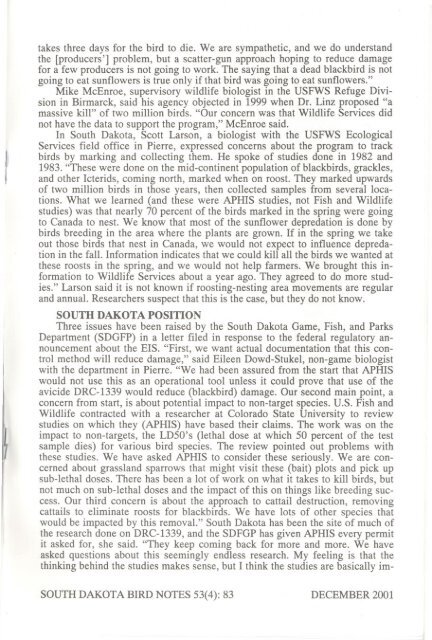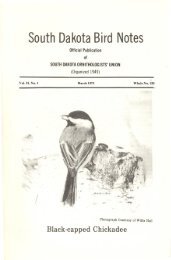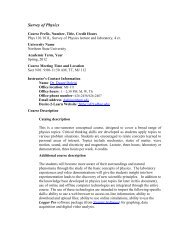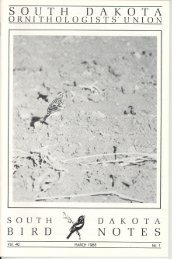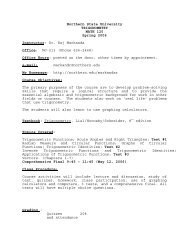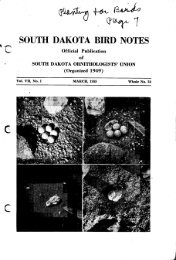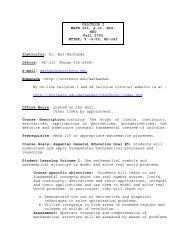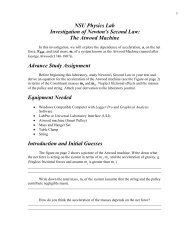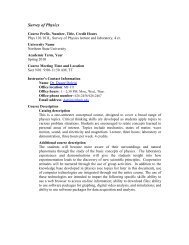Ms. Eliason prepared the Minnesota response to the EIS scoping document,submitted by letter on June 20. In it, the DNR asked for data to support the contentionby APHIS that Red-winged Blackbird populations are increasing. Itasked for specific information on blackbird problems in Minnesota. Regardingthe extent of the problem, it suggested that information APHIS provided, describingthe problem in four counties of two states, North Dakota and South Dakota,"is unlikely to be representative." The DNR sayed more information isneeded to justify lethal control, and that "such control should not be done inMinnesota based only on North Dakota and South Dakota data. The Minnesotaletter asked for justification of the effect lethal control will have on non-targetorganisms, particularly on declining, threatened, and endangered species. "TheEIS should clearly outline how bird species that have overlapping food andhabitat preferences with Red-winged Blackbirds, such as Bobolinks, will beprotected from ingesting DRC-1339-treated rice."Concerning use of glyphosate herbicide on cattail stands, the MinnesotaDNR asked for information on how cattail stands are targeted. It suggests a sitespecificreview to determine possible adverse effects of this herbicide treatmenton non-target organisms. The effect of cattail control on plant communities andrare species should be addressed in the EIS. It also asked for information on theimpact of glyphosate on insect populations.'A VERY LOCAL PROBLEM'Proof is needed to show the suggested link between spring concentrations ofbirds in South Dakota and fall predation of sunflower crops in North Dakota,according to Kevin Johnson, an environmental contaminant biologist withUSFWS in Bismarck. "Years ago, Wildlife Services marked male blackbirds asthey came through in the spring," Johnson said. "Collecting the marked birds inthe summer, they found that the majority of these birds were going to Canadaand were not the problem birds in North Dakota. Fish and Wildlife said, 'Youare not killing the right birds. No wonder you can't measure the affect.' Weasked Wildlife Services to determine if females flocking in South Dakota in thespring also are going to Canada." That is the study for which Dr. Homan andothers were collecting bird samples early this summer. "There are too manyquestions and not enough answers. The problem is that Wildlife Services has ascatter-gun approach to a very local problem. They have stated that blackbirddamage occurs in predictable locations. If that is true, let's go to the place wherethe problem is," said Johnson.The Red-winged Blackbird is possibly the most numerous North Americanspecies, and the number of birds is not at issue here, Johnson said. The issue isthe arbitrary approach being taken, killing wildlife to produce crops, and thequestion is, is this effective? "We need a means to measure effectiveness," hesaid. "If previous data suggests this is not effective, why are we doing it?"Non-target birds also are an issue. USFWS has asked for more studies onthis. "We are not comfortable with the non-target aspect of this," Johnson said."From studies done in both fall and spring, we were told non-targets don't visitbait sites. We have found this is not true. Subsequent studies also have shownthat non-target species did eat the treated rice. Now we are told these birds arenot dying from this, because no dead non-target birds are found. This is the migrationperiod. The birds are coming in, picking up food, and they are gone. ItSOUTH DAKOTA BIRD NOTES <strong>53</strong>(4): 82 DECEMBER <strong>2001</strong>
takes three days for the bird to die. We are sympathetic, and we do understandthe [producers'] problem, but a scatter-gun approach hoping to reduce damagefor a few producers is not going to work. The saying that a dead blackbird is notgoing to eat sunflowers is true only if that bird was going to eat sunflowers."Mike McEnroe, supervisory wildlife biologist in the USFWS Refuge Divisionin Birmarck, said his agency objected in 1999 when Dr. Linz proposed "amassive kill" of two million birds. "Our concern was that Wildlife Services didnot have the data to support the program," McEnroe said.In South Dakota, Scott Larson, a biologist with the USFWS EcologicalServices field office in Pierre, expressed concerns about the program to trackbirds by marking and collecting them. He spoke of studies done in 1982 and1983. "These were done on the mid-continent population of blackbirds, grackles,and other Icterids, coming north, marked when on roost. They marked upwardsof two million birds in those years, then collected samples from several locations.What we learned (and these were APHIS studies, not Fish and Wildlifestudies) was that nearly 70 percent of the birds marked in the spring were goingto Canada to nest. We know that most of the sunflower depredation is done bybirds breeding in the area where the plants are grown. If in the spring we takeout those birds that nest in Canada, we would not expect to influence depredationin the fall. Information indicates that we could kill all the birds we wanted atthese roosts in the spring, and we would not help farmers. We brought this informationto Wildlife Services about a year ago. They agreed to do more studies."Larson said it is not known if roosting-nesting area movements are regularand annual. Researchers suspect that this is the case, but they do not know.SOUTH DAKOTA POSmONThree issues have been raised by the South Dakota Game, Fish, and ParksDepartment (SDGFP) in a letter filed in response to the federal regulatory announcementabout the EIS. "First, we want actual documentation that this controlmethod will reduce damage," said Eileen Dowd-Stukel, non-game biologistwith the department in Pierre. "We had been assured from the start that APHISwould not use this as an operational tool unless it could prove that use of theavicide DRC-1339 would reduce (blackbird) damage. Our second main point, aconcern from start, is about potential impact to non-target species. U.S. Fish andWildlife contracted with a researcher at Colorado <strong>State</strong> <strong>University</strong> to reviewstudies on which they (APHIS) have based their claims. The work was on theimpact to non-targets, the LD50's (lethal dose at which 50 percent of the testsample dies) for various bird species. The review pointed out problems withthese studies. We have asked APHIS to consider these seriously. We are concernedabout grassland sparrows that might visit these (bait) plots and pick upsub-lethal doses. There has been a lot of work on what it takes to kill birds, butnot much on sub-lethal doses and the impact of this on things like breeding success.Our third concern is about the approach to cattail destruction, removingcattails to eliminate roosts for blackbirds. We have lots of other species thatwould be impacted by this removal." South Dakota has been the site of much ofthe research done on DRC-1339, and the SDFGP has given APHIS every permitit asked for, she said. "They keep coming back for more and more. We haveasked questions about this seemingly endless research. My feeling is that thethinking behind the studies makes sense, but I think the studies are basically im-SOUTH DAKOTA BIRD NOTES <strong>53</strong>(4): 83 DECEMBER <strong>2001</strong>
- Page 1:
I .SOUTH DAKOTA IORNITHOLOGISTS'UNI
- Page 4 and 5:
fication of Birds of North America
- Page 6 and 7:
- - ~1180 individuals banded and 20
- Page 8 and 9:
L--: --..Dean, K. L. 1999. Stopover
- Page 10 and 11:
I was listening to an unusual sparr
- Page 12 and 13:
..of Black-backed Woodpeckers incre
- Page 14 and 15:
.~24 Sep Meade JLB ... Late [l5-Nov
- Page 16 and 17:
..-- --- --Yankton SVS; 02 Aug Robe
- Page 18 and 19:
..American Tree Sparrow Early: 03 O
- Page 20 and 21:
PubUshed bySOUl1l DAKOTAORNI1HOLOGI
- Page 22 and 23:
SOUTH DAKOTA BIRD NOTES, the offici
- Page 24 and 25:
..ess that is being fought against.
- Page 26 and 27:
White-fronted Goose 13% 6Snow Goose
- Page 28 and 29:
Hairy Woodpecker 91% 41Black-backed
- Page 31 and 32: - - -Grzybowski, 1. A. 1999. Southe
- Page 33 and 34: en0ẹ..,::r:t:J~0~OJ....:;.:;t:JZ0
- Page 35 and 36: ~A GUIDE TO THE BIRDS OF THE PHILIP
- Page 37 and 38: Brookings KIE; 11 Feb Hughes RDORed
- Page 39 and 40: TJ; 20 Jan Hughes JSP, RFSPurple Fi
- Page 41 and 42: ~!I: ORNITHOLOGISTS'I SOUTH DAKOTAU
- Page 43 and 44: ..~PRESIDENT'S PAGEI had such a bla
- Page 45 and 46: -erably prior to consulting a field
- Page 47 and 48: SUBMITTEDFOR CONSIDERATIONEurasian
- Page 49 and 50: '"young cormorants, near flight sta
- Page 51 and 52: - --"only one genus of the family S
- Page 53 and 54: ~SEASONAL REPORTSThe 2001 Spring Se
- Page 55 and 56: ----KM; 08 Apr Butte JLBCinnamon Te
- Page 57 and 58: ,-----0Apr Minnehaha RBA; 17 May Be
- Page 59 and 60: Pileated Woodpecker Only Report: 15
- Page 61 and 62: 07 MayUnion RBA ...Late: 12 May McC
- Page 63 and 64: ,I~haha RFS, JSP; 11 May Meade EEMB
- Page 65 and 66: Contributing ObserversRBADBJLBKBAPB
- Page 67 and 68: .~lSD State Lists (31 December 2000
- Page 69 and 70: - ---- JSOU T H D A K 0 r~ORNITHOLO
- Page 71 and 72: ...~PRESIDENT'S PAGEThe September m
- Page 73 and 74: emained at the refuge for 11 days b
- Page 75 and 76: _INelson has cut back sunflower pla
- Page 77 and 78: problems." He explained that Wildli
- Page 79 and 80: within two hours.) Some non-target
- Page 81: '\of USFWS, Mountain-Prairie Region
- Page 85 and 86: - ,..,rcording to Gamble.NORTH DAKO
- Page 87 and 88: ~IrSMALL RESEARCH GRANTS AVAILABLE
- Page 89 and 90: ';IWhite-faced Ibis reported from H
- Page 91 and 92: Whip-poor-will Reported from Lincol
- Page 93 and 94: Meade, Pennington and Stanley co.Ea
- Page 95 and 96: REPRFSSSNSSVSDRSDSRandy E. PodollRo


